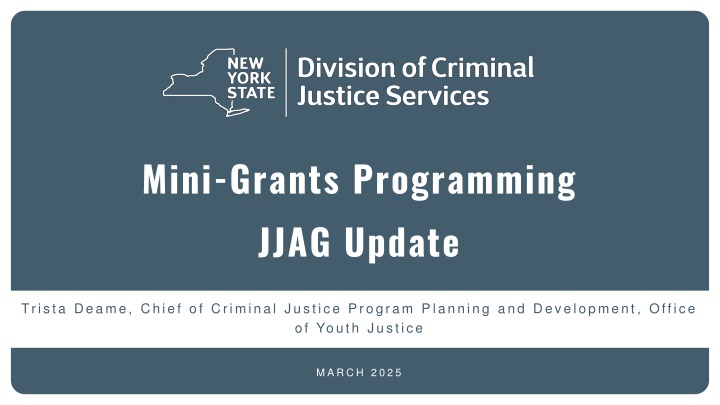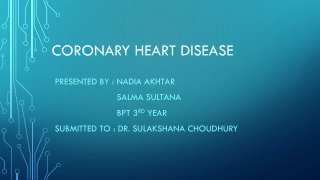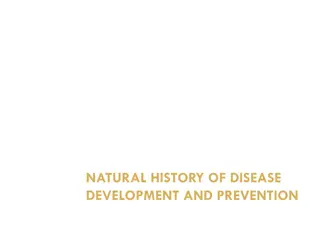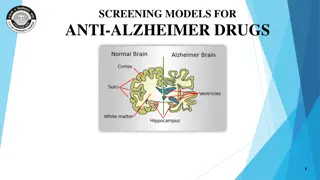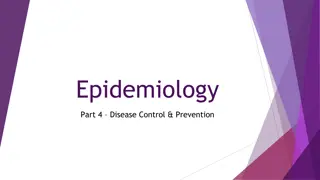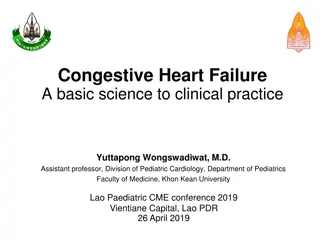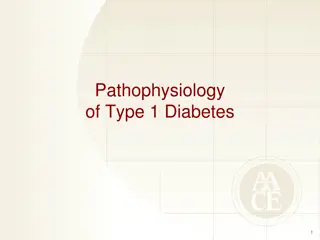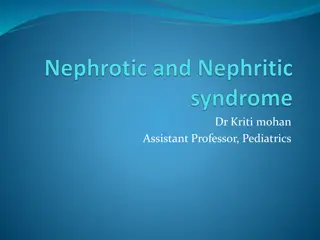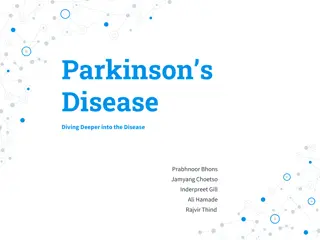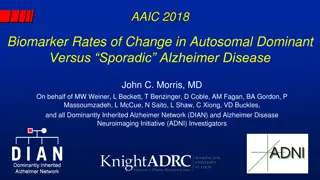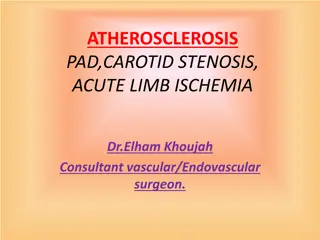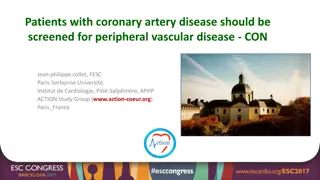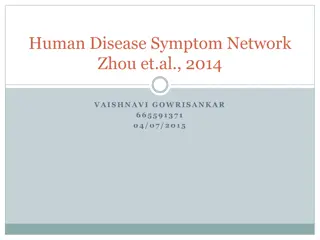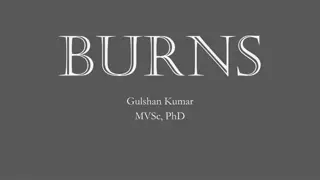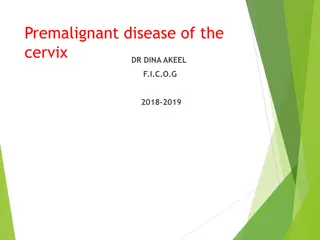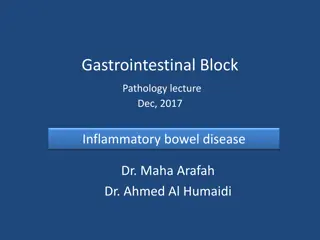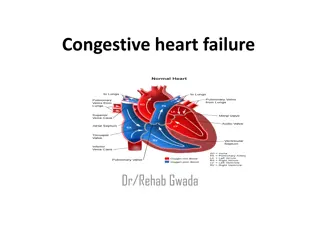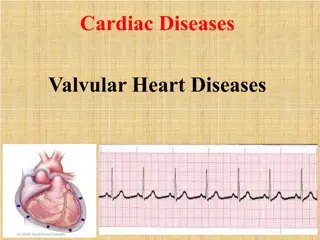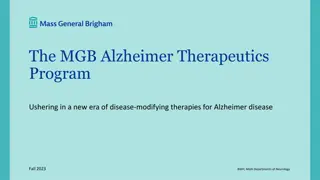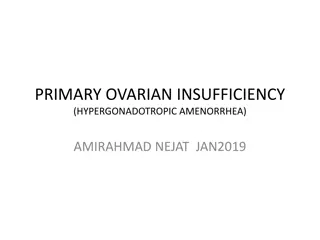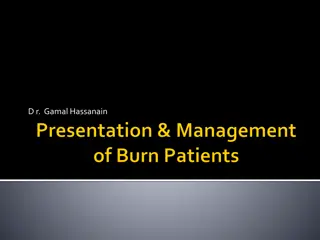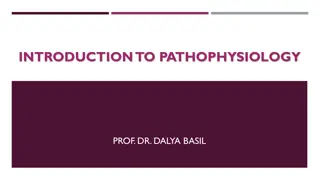Introduction to Pathophysiology: Understanding Disease Processes
Pathophysiology is the study of altered physiological processes associated with injury or disease, focusing on how the body reacts to fight off disease. It encompasses the causes, origins, nature, and outcomes of diseases, analyzing bodily fluids and tissues to aid in diagnosis and treatment. Clinical pathology involves laboratory analysis of bodily fluids and tissues for disease diagnosis. Explore the field of pathology for a deeper understanding of diseases.
Download Presentation

Please find below an Image/Link to download the presentation.
The content on the website is provided AS IS for your information and personal use only. It may not be sold, licensed, or shared on other websites without obtaining consent from the author.If you encounter any issues during the download, it is possible that the publisher has removed the file from their server.
You are allowed to download the files provided on this website for personal or commercial use, subject to the condition that they are used lawfully. All files are the property of their respective owners.
The content on the website is provided AS IS for your information and personal use only. It may not be sold, licensed, or shared on other websites without obtaining consent from the author.
E N D
Presentation Transcript
Mini-Grants Programming JJAG Update Trista Deame, Chief of Criminal Justice Program Planning and Development, Office of Youth Justice M A R C H 2 0 2 5
Mini-Grant Bid Response Results: Selected Geographic Locations NYC 6 grantees ROS 9 grantees Murphy, and Omar Cyrille from OYJ; and Tonya Tamir from OPDF. Responses were automatically disqualified if organizations were not pre-qualified in the State Financial System. 3 DIVISION OF CRIMINAL JUSTICE SERVICES
Selected Grantees Big Brothers Big Sisters of Westchester Location: Westchester Problem Statement: Youth ages 14-17 are seeing increased juvenile justice system involvement, increase in mental health and mental illnesses, and are increasingly skipping school. Youth serving-systems (county social services, school systems, juvenile delinquency systems, law enforcement) struggle to engage youth and their families to address the issues directly. Families affected by these issues suffer from years of having their families devalued by the systems attempted to engage them. Mistrust of social service and law enforcement systems due to poor experiences exacerbated by the lack of education, and responsibility to ensure their staff receive current and accurate training on family system work, including systemic family therapy and ACES, unconscious bias and a perceived lack of respect for the family and community make it difficult to engage these youth in a positive and life-changing experience. Program Goals: Goal #1: Engage youth and families impacted by the juvenile/criminal justice system to better understand their needs and give them a voice when making decisions about programs and service delivery. Goal #2: Increase access to trauma, healing, and mental health services. Goal #3: Expand enrollment in BBBS of Westchester and Putnam to prevent youth involvement in the justice system and increase opportunities for young people. Program Strategies: One to one mentorship: pair justice involved-youth with trained, supportive mentors who will provide 1:1 guidance. Comprehensive mentor training: provide specialized training on working with at-risk youth, trauma, and the challenges faced by those in the justice system. Increased Access to Mental Health Services: P/T licensed mental health therapist will provide free and confidential mental health and trauma- informed support. Staff will be culturally competent and bilingual. 4 DIVISION OF CRIMINAL JUSTICE SERVICES
Selected Grantees Bravehearts MOVE New York, Inc Location: Westchester Problem Statement: Nationally conducted youth and family engagement studies demonstrate the need for improved equity efforts for youth and their caregivers to better understand their rights, resources and the terminology used to make decisions about their treatment and case planning goals. Additionally, justice affected young adults who reside in residential care are uniquely cross-system impacted before being introduced to the justice system. They experience social-emotional and education challenges that go unaddressed, leading to unwarranted engagement with the justice system and removal from their communities. Caregivers of these youth experience historic systemic mistrust and are often lacking equitable access to information to make meaningfully informed decisions that are at the best interests of their families. Program Goals: Goal #1: Create a statewide peer workgroup of residential placement impacted youth and their caregivers. Goal #2: Create an online informational space that defines and describes NYS Justice terminology, process, procedure, rights, and resources. Program Strategies: Create restorative offering materials to send out to residentially placed youth, families and caregivers. Facilitate restorative offering sessions to youth in residential placement and their families, both virtually and in person. Create a workgroup to gather information and develop online resources for creation of informational space. Host bi-weekly workgroup spaces for information collection and review of independent research assignments. 5 DIVISION OF CRIMINAL JUSTICE SERVICES
Selected Grantees Center for Alternative Sentencing and Employment Services (CASES) Location: Harlem Problem Statement: The need for highly accessible, high-quality mental health care for young people in New York City (NYC) is urgent: 16% of adolescent New Yorkers report seriously considering suicide and 36% persistent feelings of sadness and hopelessness. A 2021 survey of more than 1,300 young people in NYC found more than a third wanted or needed mental health services, but that les than half reporting this need were receiving services. Office of Mental Health (OMH) hospital re-admission data indicates that nearly a third of youth discharged from a psychiatric stay at a general hospital in the city end up back in an emergency room within three months. Given the continued reliance on the criminal justice system to respond to people experiencing mental health crisis, failure to provide effective care for a young person with mental health needs routinely contributes to early criminal justice system involvement, an outcome that can lead to a chronic cycle of arrests and incarceration. CASES Nathaniel Clinic is the only criminal justice specialist clinic in New York City that is licensed to serve youth under the age of 18. It is also only clinic nation-wide implementing the best practice Certified Community Behavioral Health Clinic (CCBHC) model, which emphasizes delivery of a range of same-site, highly integrated services: mental health care, substance use treatment, primary health care, and crisis intervention along with peer, family, and case management services. Program Goals: Goal #1: Increase the number of youth ages 12-17 annually served by the Nathaniel Clinic by at least 33%. Goal #2: Sustain the 60% retention rate of youth ages 12-17 attending at least four clinic appointments. Program Strategies: Expand recruitment and outreach efforts to key stakeholders throughout the city to increase the number of those youth served by the clinic. Increase clinic s youth-specialist LCSW capacity to provide clinical intervention to young people experiencing mental health struggles. Strengthen retention strategies, including follow-up and personalized outreach. 6 DIVISION OF CRIMINAL JUSTICE SERVICES
Selected Grantees Community Mediation Services (CMS) Location: Queens Problem Statement: Since 2012, CMS has operated the Advocate and Mentor (AIM) program, providing intensive mentoring and advocacy for court involved youth aged 12 to 15, with a strong parental engagement component. Many of the young people and families served have experienced significant trauma, which can negatively impact behavior, decision-making, and overall well-being. Understanding trauma and its effects is critical for both youth and parents to being the healing process and address the root causes of maladaptive behaviors. By increasing awareness, participants can develop the necessary tools to navigate their trauma and improve their emotional and social development. Additionally, it is important to build effective communication and increase resilience amongst participants. Doing so will allow both youth and parents to better navigate challenges, resolve conflicts and build strong support networks which are critical for long-term positive outcomes. Program Goals: Goal #1: Enhance understanding of Trauma and Its Effects through youth and parental weekly group sessions and monthly parent workshops. Goal #2: Develop Effective Communication and Support Strategies to break maladaptive patterns and foster healthy relationships between youth and their families. Goal #3: Build Resilience and Mitigate the Effects of Traumas by empowering participants to foster and model positive relationships and develop emotional regulation skills. Program Strategies: Youth program for youth ages 12-17. operating under a cohort model, the program will operate three cohorts per year with eight youth per cohort. The program will include 12 weeks of weekly group workshops utilizing Trauma-Focused Cognitive Behavioral Therapy (TF-CBT); individual support sessions, recreational and prosocial activities, as well as an evaluation and assessment component. Parent support group for parents of high-risk probation involved youth and adult probation clients who are parents of children in the same age range. This will include monthly virtual sessions with 10 participants per session focused on trauma education, parenting strategies, self-care and stress management. 7 DIVISION OF CRIMINAL JUSTICE SERVICES
Selected Grantees Cornell Cooperative Extension Association of Jefferson County Location: Jefferson and Lewis County Problem Statement: Since 2005, the 4-H afterschool program has been running in Jefferson and Lewis Counties. Today, the program has expanded to 18 school age childcare licensed program sites. However, the program is being met with a significant number of youth experiencing behavioral challenges, mental health diagnoses and special needs which require specialized individual support to fully benefit from the afterschool programs. Located in mostly rural areas of New York state all after school programs are grant funded and lack considerable infrastructure and financial resources compared to other regions throughout the state. According to the NYS Council on Children and Families, these sites are located in childcare deserts, all 18 programs have significant waitlists leaving parents with unsafe options for afterschool and summer care. The Community suffers from unique challenges related to poverty, unemployment, and lack of transportation. According to the 2022 Jefferson County Prevention Needs Assessment study Survey results, the percentage of disconnected youth is higher than the states (10% vs 6%). In January 2024, a community survey was conducted at three elementary sites, with results demonstrating that students were at a high risk for bullying (77%), depression and/or suicidal thoughts (60%); drug/alcohol abuse (56%), dropping out of high school (30%), teen pregnancy (21%) and gang violence (10%). Additionally, 70% of respondents indicated that there are not sufficient opportunities in the community for youth to participate in educational programming outside of the school day and 92% indicated there is a high need for 4-H afterschool programming. Program Goals: Goal #1: Enhance the 4-H afterschool environment to support youth with high needs effectively through the implementation of afterschool and summer programming for students in grades K-12. Goal #2: Provide youth and families the resources and supports needed to decrease interaction with the juvenile justice system by hiring two Student and Family Support Specialists to work individually with high needs youth and their families. Program Strategies: Implement afterschool and summer programming for students in grades K-12 Hire two student and family support specialists to work individual with high needs youth and their families to provide support 8 DIVISION OF CRIMINAL JUSTICE SERVICES
Selected Grantees Erie County Restorative Justice Coalition (ECRJC) Location: Buffalo Problem Statement: The 21stCentury brought about recognition that a punishment-focused juvenile justice system fails to appropriately attend to the developmental needs of youthful offenders. This recognition ushered in what Guidi Weiss (2013) refers to as the fourth wave of juvenile justice which is aimed at holding young offenders accountable for their actions in developmentally appropriate ways; reducing reoffending and ensuring public safety; and producing positive outcomes for children, families and communities. In response to this fourth wave ECRJC developed the Leading with Our Own Resilience Everyday (LORE) program, a restoratively based project for at-risk youth and delinquent youth. LORE offers relationship-building within a community of support, and opportunities to develop social-emotional skills that will decrease the likelihood of placement and delinquency, prevent recidivism and promote resilience among the previously defined youth population. Program Goals: Goal #1: Increase the number of at-risk and justice-involved youth who participate in restorative practice talking circles through bi-weekly gatherings. Goal #2: Develop social-emotional skills in justice-involved youth. Goal #3: Engage in community-trust building and refine a restorative youth development model aimed at healing and promotion of positive youth development opportunities through a participatory action research (PAR) project. Goal #4: Increase youth awareness and access to community resources and culturally relevant service providers. Program Strategies: Bi-weekly restorative circle gatherings for youth who have been identified at-risk of delinquency and those youth who are involved in the system. Circles will incorporate social-emotional learning activities in the areas of self -, social-, and emotional-awareness; critical decision making and relational skills. Conduct a Participatory Action Research (PAR) Project to gain insight on: youth perspectives and recommendations on program refinement. 9 DIVISION OF CRIMINAL JUSTICE SERVICES
Selected Grantees Global Kids Location: Brooklyn Problem Statement: Children of incarcerated parents and those living in single-parent households face unique challenges that can significantly affect their emotional, social, and academic well-being. According to the NYC Department of City Planning community district profiles, 54% of residents identify as Black, 18% as Hispanic/Latinx, 4% as Asian, 21% as White, and 3% as another race in Bed-Stuy. One in five residents are foreign-born. The gentrification of Bed-Stuy over the last decade has resulted in a bimodal distribution of wealth among residents. As youth in this community are much more likely to experience economic hardship, lack access to the academic resources and leadership opportunities more readily available to their peers in affluent neighborhoods, and more likely to experience obstacles to learning and disconnection from school. Recent data shows that in NYC public high schools, 24% of Black and 23% of Latino students reported having a parent in jail or prison, compared to 11% of White students. In addition, one third of children in New York City live in a single-parent household. Data shows that children of incarcerated parents and single parent homes face several risk factors, including a higher risk of academic difficulties and lower educational attainment due to disruptions in their home life and support systems, as well as reduced access to educational support. The Future Forward Program aims to address these challenges at Crispus Attucks Elementary School (CS21) targeted to the community s significant needs. Program Goals: Goal #1: Implement the Future Forward Initiative to raise awareness and garner support for children of incarcerated parents and those living in a single-parent households at Crispus Attucks Elementary School (K-5). Goal #2: Build Community and social/emotional skills for children with incarcerated parents. Program Strategies: Social-emotional wellness interventions to build key competencies in self-management, self-awareness, social-awareness, relationship skills, and responsible decision-making. Workshops and activities designed to prepare fifth-grade students for the transition to middle school, focusing on both academic readiness and emotional skills. 10 DIVISION OF CRIMINAL JUSTICE SERVICES
Selected Grantees Good Shepard Services Location: Brooklyn Problem Statement: Arches transformative mentoring program supports high-risk young people (16-24) who struggle to overcome the thinking patterns and behaviors that led them to be court involved and commit negative and destructive activities in their community. The vast majority of youth that families serviced by Good Shephard Services reside in the low income, under-resourced Brooklyn neighborhoods of East new York, Brownsville, and Bed-Stuy. Residents struggle with the impacts of a history of systemic policies rooted in racism that have resulted in disinvestment in housing, employment, education, and health services, with too many people not having access to the resources that enable them to achieve success. Further, indicators of neighborhood stress from recent census and NYS data reveal higher than average rates of unemployment, disconnected youth, violent crime, and foster care placement. COVID-19 heightened these issues, as families lost jobs and income, experienced sickness and death, and children had to confront heightened feelings of isolation, depression, anxiety, and disruptions to their schooling. Program Goals: Goal #1: Build a community of supportive peers for parents/caregivers of youth in AIM, Arches, ATD, and parent support programs. Goal #2: Connect parents/caregivers to critical resources and community-based services that address the unmet needs of families. Goal #3: Create a parent/caregiver advisory council to give voice and co-design programming and services offered. Program Strategies: Form an advisory council comprised of three parent/caregivers of young people in youth justice programs. Members will co-lead and co- design all activities and services offered, and each member will be stipend for their time. Monthly family engagement workshops for parents/caregivers will design and lead each workshop. Host three family celebrations for youth justice programs. 11 DIVISION OF CRIMINAL JUSTICE SERVICES
Selected Grantees Infinity Visual and Performing Arts, Inc Location: Jamestown Problem Statement: According to the National Mentoring Partnership, approximately 40% of teenager s waking hours are spent without the supervision of an adult. Studies show that 1 and 3 youth grow up without a mentor. A mentor, such as an Infinity instructor, adds another adult presence in a young person s life, another person to be accountable to, and another person to receive support and acceptance from. Music and the arts are for everyone and are present in every culture throughout the world. Creative pursuits provide a powerful and health outlet for young people to express feelings and unique perspectives and connect with others across cultural and social divides. Studies show that low- income students with access to arts and cultural resources and mentorship demonstrates higher school engagement, score higher on standardized tests, are more likely to attend college, vote, and volunteer in their community and are less likely to engage in high-risk behaviors. Program Goals: Goal #1: Provide Positive Youth Development Through Arts-Based Mentorship. This will include group classes, workshops, and performance opportunities. Goal #2: Build Community Engagement and Promote Inclusion through Collaborative Arts Activities through classes and workshops focusing on story telling through music, the arts, and performance. Program Strategies: Implement new classes designed to promote collaboration and inclusion, with a focus on storytelling through music, arts and performance. Introduce leadership opportunities for students from diverse backgrounds to inform the development of new classes and performances. Hold community showcase events where students present their work, fostering dialogue and connection between youth and the broader community. Establish an inclusive advisory group of students to provide input into programming. 12 DIVISION OF CRIMINAL JUSTICE SERVICES
Selected Grantees Integrated Community Alternatives Network (ICAN) Location: Utica Problem Statement: Youth, family, and community engagement is proven to result in improved outcomes and reduce the chances of youth justice system involvement. Employing a positive youth development model and practices that encourage youth and family voice is also proven to support youth s healthy development. These approaches also help ensure that services and programs are relevant and responsive to the unique needs and assets of youth, families and communities. Few opportunities currently exist in the region for the most marginalized populations and communities to inform and influence system leaders. Data shows that the Mohawk Valley region, youth lack access to youth- centered prevention programs ground in positive youth development principles, especially those that include a focus on restorative practices and trauma and healing. According to the 2022-2024 Community Needs Assessment, there needs to be more structured programs for children and teens that encourage their engagement. Youth in the community are still recovering from the trauma of COVID-19 pandemic and the lasting social emotional, and behavioral health challenges. The region is designated as mental health service provider shortage area. Program Goals: Goal #1: Increase youth, family, and community engagement and decision making in youth justice systems and services, especially among those most impacted by the justice system in the Mohawk Valley. Goal #2: Increase prevention efforts and youth-centered service delivery in the Mohawk Valley. Goal #3: Increase access to services, including behavioral health services, that focus on healing from trauma in the Mohawk Valley. Program Strategies: Connect youth at risk of justice system involvement to system and community leaders and provide opportunities for positive youth development, community trust building, and new pathways for collaborative approaches. Implement evidence-informed Tilly s Focused Individual Training Prevention Program for up to 100 youth in grades 5-8 and 50 parents, providing bimonthly one-hour workshops and mentoring services. 13 DIVISION OF CRIMINAL JUSTICE SERVICES
Selected Grantees Justice Innovation, Inc. d/b/a Center for Justice Innovation Location: Syracuse Problem Statement: Data shows that incarcerating youth does not reduce delinquent behavior, increase public safety, or decrease recidivism. Youth released from juvenile detention and correction facilities often face high rates of arrest, new adjudications or convictions, and reincarceration. Incarceration is a traumatizing experience with contributes to heightened anxiety, diminished self-efficacy and self-esteem, lack of motivation and engagement, increased feelings of anger and hopelessness, disconnection from family and community resources, and disruptions in education that can have negative impacts on future academic and career success. In NYS mental health and substance use issues continue to worsen for youth in secure detention facilities. Data shared in the 2024 NYS Comptroller s audit on several of the state s youth correction and detention centers indicated that between January 1, 2019 December 31, 2022, increased contraband incidents and positive drug tests in facilities. For the first time since 2022, Hillbrook Juvenile Detention Center has reached its 32-bed capacity. Additionally, data shows that the top charge for detention admissions was for violent felony offenses across all levels of populations. Program Goals: Goal #1: Implement the Hillbrook Restorative Response Project, designed to improve the social-emotional health and well-being for youth incarcerated at the Onondaga County Hillbrook Juvenile Detention Center. Goal #2: Create a restorative justice learning community between Hillbrook staff and the Center s restorative justice team to establish new restorative practice models and build internal capacity of the Hillbrook Restorative Response Project. Program Strategies: Implement evidence-based restorative justice model to manage conflict in facilities. Utilize credible messenger model, employing staff, that have diverse backgrounds. Facilitate two five-week cohorts of restorative circles at each of the five Hillbrook detention units and serve a total of 50 unduplicated youth. Utilize Once Circle Foundation evidence-based facilitation programs. 14 DIVISION OF CRIMINAL JUSTICE SERVICES
Selected Grantees Peekskill City School District Location: Westchester Problem Statement: Behavioral incident's data show an increase of 17% from 2021-2022 and 2022-2023 and a 9% increase from 2022-2023 and 2023-2024 school years. District data shows that suspensions, superintendent s hearings for significant code of conduct violations and out of district placements disproportionately impact black male secondary students (middle and high school). During the 2021-2022 school year, there were 2,522 clinical or behavioral incidents which increased to 3,067 in the 2022-2023 school year. During the 2021-2022 school year Hillcrest Elementary (grades 4-5) had 47 behavioral incidents and which increased to 147 in the following year. Program Goals: Goal #1: Reduce the number of youth of color placed in detention, out of district school placements and interaction with the criminal justice systems. Increase students access to healing and behavioral services that work to prevent justice-system involvement and increase opportunities for students to graduate high school and contribute to positive population impact for the community. Program Strategies: Launch a mentoring initiative involving community members. Coordinate a student conference, focusing on the attributes that lead to post-secondary success. Provide professional development related to social, emotional and healing for stakeholders. 15 DIVISION OF CRIMINAL JUSTICE SERVICES
Selected Grantees RiseBoro Community Partnership, Inc Location: Brooklyn Problem Statement: 2024 OASAS Partnership for Success local data shows that 49.1% of Brooklyn youth surveyed age 16-20 do not feel connected to or included in community decision making and 50.9% felt they cannot speak with community leaders one-on-one, particularly when it comes to community and individual impact over policing, disproportionate arrest and incarceration rates for Black and Latinx youth. In 2023, 3,211 arrests of juveniles were made in Brooklyn, disproportionately affecting Black and Latinx youth with their arrests making up 71% and 20.8% of those arrests respectively as opposed to white juveniles making up 4.8%. Connecting community leaders and decision makers with community youth and members is important to engage in equitable discussion and development of policies and practices that will act as effective preventative measures that enhance community health and well-being. The Urban institute emphasizes the importance of valuing prevention efforts and engaging youth and credible messengers in design and co-creation of direct programming that involves them. Program Goals: Goal #1:Increase community youth involvement with community decision making and program creation in public safety and anti-violence initiatives, like the Gun Violence Prevention Task Force Neighborhood Safety Councils, local community boards and city council members to boost civic engagement and community connectedness. Goal #2: Increase prevention efforts and youth-centered service delivery via credible messengers to enhance community connectedness. Goal #3: Increase youth and community involvement and engagement via artivisim in North and Central Brooklyn. Program Strategies: Engage community youth in artivisim to build their knowledge in self-selected topics with programming and events. Implement afterschool and weekend mentorship and co-creative arts projects between peers, mentors, and community leaders. Program will be in eight-week modules with youth selected topics. 16 DIVISION OF CRIMINAL JUSTICE SERVICES
Selected Grantees Say Yes Buffalo Scholarship, Inc. Location: Buffalo Problem Statement: 2022 data shows that Buffalo Public Schools had the highest suspension rate of all New York State School districts with nearly 1 in 6 students receiving out-of-school suspensions, and with Black students receiving suspensions at 2.5 times the rate of their White peers. Top reasons for suspensions were defiance of authority, fighting, disrespectful behavior, inciting or participating in a disturbance, and cutting class. Considerable research illustrates the connection between school suspensions and the school-to-prison pipeline. There is a significant need for youth-centered, non-punitive programming designed to positively engage young men of color across the Buffalo community. Data shows that the rate of chronic and severe absenteeism for Black and Hispanic students are significantly higher than their White Peers. Research suggests chronic absenteeism from school is linked to lower academic achievement, increased dropout rates, poor social-emotional development, higher likelihood of risky behaviors, and long-term challenges in employment and earning potential. Program Goals: Goal #1: Increase the availability of positive, empowering, youth-led and youth-centered programming focused on boys and young men of color across WNY, with a focus on the City of Buffalo, through the Breaking Barriers Youth Leadership Council. Goal #2: Reduce disproportionately high rates of chronic and severe absenteeism among Black and Hispanic students in Buffalo s Public Schools and improve academic engagement, social-emotional development, and long-term success. Program Strategies: Engage 50 young men of color ages 12-24 in the Break Barriers Youth Leadership Council, an intensive year-long extracurricular youth mentorship and empowerment program focused on cultivating personal growth and leadership skills, and elevating youth voices to advocate for social justice, racial equity, and policy change. Expand implementation of the Say Yes Buffalo Boys and Men of Color Initiative through school day programming. 17 DIVISION OF CRIMINAL JUSTICE SERVICES
Selected Grantees Say Yes Buffalo Scholarship, Inc. Location: Staten Island Problem Statement: The Staten Island (SI) poverty rate is high at 14.5%, with higher rates of poverty in the St. George and Stapleton sections of the Staten Island. In these areas, residents may be up to 29% below the federal poverty level. About 20% of the population is foreign-born, with a large Russian, Polish, Sri Lankan, and Chinanteco-speaking Mexican American populations. Most of SI s Hispanic and African American residents live north of the Staten Island Expressway. In 2020, SI s overdoes death rate was the second highest in NYC (37 per 100,000 residents). The rural and often remote nature of Staten Island creates issues for people with behavioral health challenges who may already feel isolated, with comparative lack of public transportation serving as an additional barrier to access. SI has a higher mental health client to provider ration than that of NYC or in the U.S. , just one facet of how SI residents have the least access to quality mental health and medical health care of all five boroughs. Program Goals: Goal #1: Reduce the number of Staten Island families seeking placement and/or PINS Warrants for youth through by increasing the number of youth served by Jewish Board MST-SA JJI and FAP behavioral health programs. Goal #2: Increase the number of at-risk young people who are in school or working through collaboration with the youth, caregiver and school to find the appropriate education/vocational setting where the youth can be successful. Program Strategies: Increase the number of youth served by Jewish Board MST-SA JJI and FAP behavioral health programs through outreach events and strengthened community partnerships. Collaborate with each youth, caregiver, and school involved in Jewish Board MST-SA JJI & FAP programs to find the appropriate educational/vocational setting where the youth can be successful. 18 DIVISION OF CRIMINAL JUSTICE SERVICES
